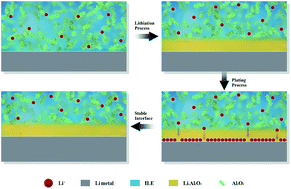A leaf-like Al2O3-based quasi-solid electrolyte with a fast Li+ conductive interface for stable lithium metal anodes†
Abstract
Poor interfacial contact and Li dendritic growth severely restrict practical applications of Li metal anodes. Herein, we report a novel biomimetic solid-state electrolyte based on injection of 1 M LiTFSI-Py13TFSI ionic liquid electrolyte into a leaf-like Al2O3 skeleton through an in situ sol–gel method. This structure is intended to address the poor contact at the interface and protect the Li metal anode. A large amount of ionic liquid electrolyte was absorbed by the leaf-like Al2O3 skeleton owing to its high specific surface area. This system improved the ionic conductivity and promoted migration of Li+ both in the bulk and at the interface. The lithiophilic Al2O3 skeleton was in close contact with metallic Li and formed a fast Li+ conductive layer (Li–Al–O composition), which facilitated uniform deposition of Li and thus inhibited Li dendrite formation during long-term cycling. Moreover, density functional theory calculations indicated spontaneous generation of a Li–Al–O layer and [Py13]+ in the ionic liquid facilitates this process. Symmetric Li cells assembled with this electrolyte exhibited an extremely long cycle lifetime of 1100 h at a high constant current density. This strategy of a biomimetic leaf-structured electrolyte with a Li–Al–O conductive layer at the interface addresses problems of solid-state Li metal batteries and provides an alternative system for practical applications.



 Please wait while we load your content...
Please wait while we load your content...